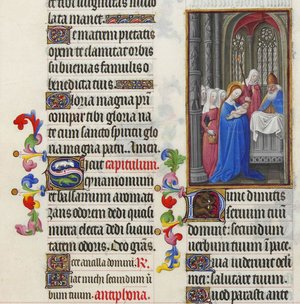- Nunc dimittis
-
 La presentación en el templo por Giovanni Bellini.
La presentación en el templo por Giovanni Bellini.
El Nunc dimittis (también llamado El Cántico de Simeón) es un cántico del Evangelio de Lucas,[1] así llamado por sus primeras palabras en latín.[2] Es uno de los tres Cánticos Evangélicos, siendo los otros dos El Magníficat o Cántico de María y Benedictus o Cántico de Zacarías.Dentro de la Liturgia de las Horas, el Nunc dimitis es el Canto Evangélico empleado en el rezo de las completas.
Contenido
Simeón
Siméon era un devoto judío a quién el Espíritu Santo le había prometido que no moriría hasta haber visto al Salvador. Cuando la Virgen María, y San José, llevaban al Niño Jesús al Templo e Jerusalén para realizar la ceremonia de consagración del primogénito, Simeón estaba allí, y tomó a Jesús en sus brazos y recitó el canto siguiente:
Versiones
 Comienzo del Nunc dimittis en el libro de Horas Las muy Ricas Horas del Duque de Berry.
Comienzo del Nunc dimittis en el libro de Horas Las muy Ricas Horas del Duque de Berry.
El original Griego:
- Νυν απολύεις τον δούλον σου, Δέσποτα, κατά το ρήμα σου εν ειρήνη,
- ότι είδον οι οφθαλμοί μου το σωτήριόν σου,
- ο ητοίμασας κατά πρόσωπον πάντων των λαών,
- φως εις αποκάλυψιν εθνών και δόξαν λαού σου Ισραήλ.
Latín (Vulgata):
- Nunc dimittis servum tuum, Domine, secundum verbum tuum in pace:
- Quia viderunt oculi mei salutare tuum
- Quod parasti ante faciem omnium populorum:
- Lumen ad revelationem gentium, et gloriam plebis tuae Israel.
Español: Reina-Valera
- Ahora despides, Señor, á tu siervo, Conforme á tu palabra, en paz;
- Porque han visto mis ojos tu salvación,
- La cual has aparejado en presencia de todos los pueblos;
- Luz para ser revelada á los Gentiles, Y la gloria de tu pueblo Israel.
Español:
- Ahora, Señor, puedes, según tu palabra, dejar que tu siervo se vaya en paz;
- porque han visto mis ojos tu salvación,
- la que has preparado a la vista de todos los pueblos,
- luz para iluminar a los gentiles
- y gloria de tu pueblo Israel.
Inglés Biblia del rey Jacobo
- Lord, now lettest thou thy servant depart in peace, according to thy word:
- For mine eyes have seen thy salvation,
- Which thou hast prepared before the face of all people;
- A light to lighten the Gentiles, and the glory of thy people Israel.
Español: Libro de Oración Común de la Iglesia. Anglicana[3]
- Ahora despides, Señor, a tu siervo, conforme a tu palabra, en paz.
- Porque han visto mis ojos tu salvación,
- La cual has aparejado en presencia de todos los pueblos;
- Luz para ser revelada a los Gentiles, y la gloria de tu pueblo Israel
Adaptaciones Musicales
Muchos compositores han puesto música al texto, generalmente emparejado con el Magníficat.
Referencias
Categorías:- Biblia
- Oraciones cristianas
- Frases religiosas latinas
- Νυν απολύεις τον δούλον σου, Δέσποτα, κατά το ρήμα σου εν ειρήνη,
Wikimedia foundation. 2010.
